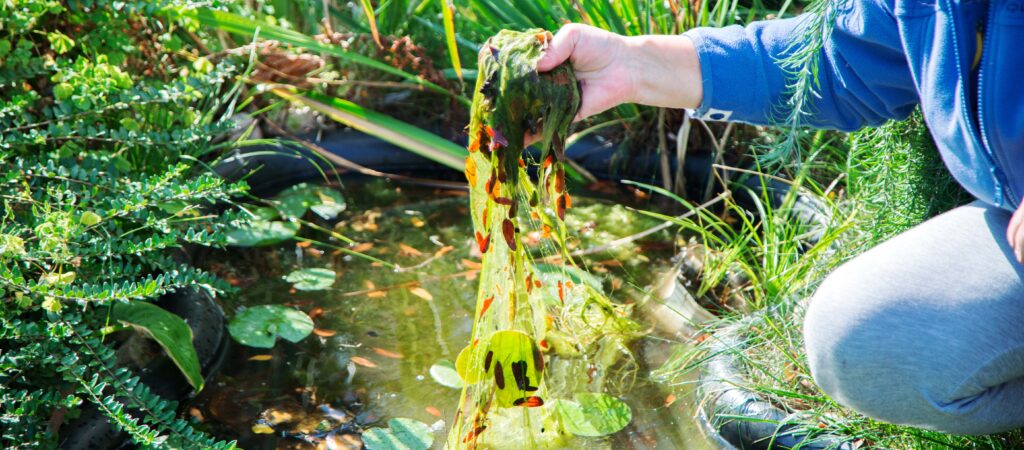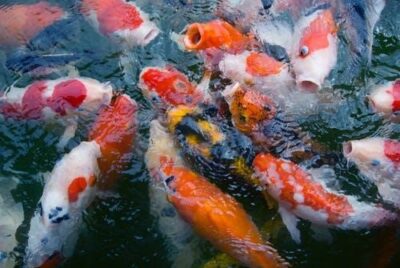You probably didn’t come across this article by accident! How to easily remove filamentous algae? How do these algae grow in the pond? Is my water quality bad? What are the consequences of filamentous algae in a pond?
“I installed a UV lamp, but I still have algae.” It is to these different topics that we will address in this guide to getting rid of algae in a pond.
Nothing is more annoying than excess algae in a pond. You want to remove it. A pond is an uninterrupted ecosystem. Converting Biological waste by bacteria into nutrients for aquatic plants, which in turn release oxygen into the water, providing a healthy environment in the pond. Even if a pond needs maintenance, problems can occur, which can upset the biological balance, resulting in unacceptable algae growth.
These filamentous algae can occur due to several factors:
- large amounts of nutrients in the water body
- high sunlight in the pond
- temperature above 18°C in the water.

How Do Algae Grow In a Pond?
Algae growth always occurs because the aquatic plants present are not able to completely remove the nutrients from a pond. Algae takes advantage of surplus nutrients.
Small particles of algae are always present in a latent state and will grow like lightning. Unlike plants, algae require little water quality. Therefore, algae grow faster in circumstances where aquatic plants cannot yet develop well.
Especially in newly constructed ponds, the growth of important oxygen producing plants will stagnate due to floating algae. The algae will make a green mass of the pond water and spoil the pond and limit the growth of plants.
How To Prevent Algae In a Pond?
We have a few tips to help you combat algae formation:
- Increase the number of aquatic plants (maximum 30%).
- It helps to remove dirt from the bottom and clean your filtration system regularly.
- Try to avoid overfeeding (everything should be gone in 5 minutes).
- Remove algae regularly by hand.
- Check the water quality.

Fighting Algae In a Pond
The first step to an algae-free pond is to test the water. Based on the results, a diagnosis and a plan help to eliminate the algae. It is now easier to determine with a pond water analysis kit.
For the pond environment, particularly, the pH value is important, as it gives us information about the CO2 content of the water. If the pH is relatively low (pH 7-8) and measured in the evening, a relatively high pond environment (pH 8-9) works, the plants will grow well. At the same time, the water will be clear.
Measures taken to increase the pH value to a more favourable level in the long term should be based on the activation of microorganisms by applying the bottom substrate and bacteria and on the establishment of pond plants that, for their supply of CO2, will not have to depend on water (floating) plants, water lilies and marsh plants). The use of peat granules can accelerate the decrease of the pH value. A pH value that is too low (pH 6 and below) indicates that the environment is becoming more acidic and poses a threat to all inhabitants of the pond.
The joint hardness of the water helps to define calcium and magnesium. Known as the GH value of the water. An appropriate GH value for pond water is between 8 ° and 12 ° GH.
Most types of pond plants will grow optimally in these values, while in this medium hard water the development and activity of microorganisms is optimal.
Carbonate hardness
(CH value) is an important pillar in the pond environment. The CH value is temporary hardness while has acid binding capacity. The formation occurs by binding free carbon dioxide (CO2) to calcium and or magnesium. It thus forms a source of carbon dioxide (CO2) for aquatic plants and algae. An appropriate CH value is between 6° and 10° GH.
If the pH-, GH- and CH-values should differ, they have to be adjusted. Special means are available to achieve this. Quickly eliminates algae
The measures mentioned here are intended to reduce the growth of fibrous algae by biological means and finally to stop it. The whole process will take several months. This period can be reduced by applying a treatment with an algae control product. Please keep in mind, however, that this type of product fights symptomatic algae but does not remove the cause.
Final Words
Equipment has been developed to permanently solve the problem of algae in garden ponds. They work on the principle of mineralization. By mineralization, the growth of fibrous and slimy algae is made impossible, while the growth of aquatic plants is stimulated.
A sustainable solution to the problem of floating algae (green water) is a UVC filter. The ultraviolet radiation will kill floating algae, germs and molds.
A filtering equipment is also a relief for the algae problem. On the one hand, the water is kept clear by filtering the water, on the other hand the water circulation will provide enough oxygen. Filtering equipment will filter the pond water both mechanically and biologically.
Mechanical filtration is based on the principle of removing organic and inorganic dirt particles and dyes. The principle of biological filtration is to achieve a better and faster conversion of organic particles by means of microorganisms. An integrated biological filter will improve the activity of the micro life and thus stimulate the growth of plants.










